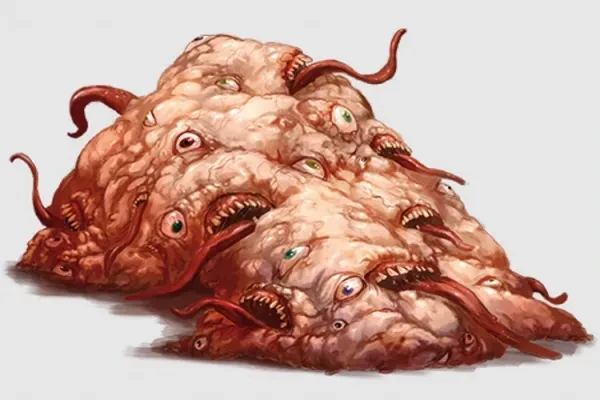
Aberrations in Pathfinder come from many different sources. The deep sea. Other planets. Other planes. Magic experiments gone horribly wrong. Magic experiments gone horribly right. Or creatures getting exposed to dark energy and mutated by it. Either way, they pose a challenge for Pathfinders.
15. Gibbering Mouther
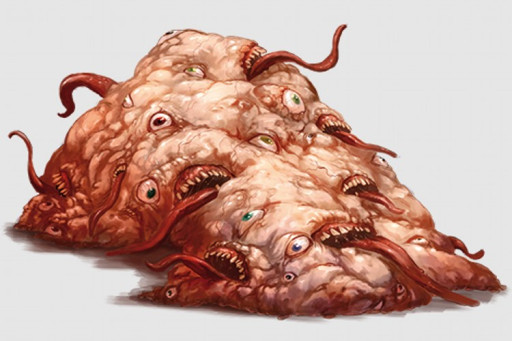
Aberrations do not make biological sense according to our understanding of biology. No more is this more true than with the Gibbering Mouther. This abomination is a lump of flesh with mouths everywhere. New mouths can appear at will or whenever it’s slashed.
Slashing the Mouther lets them sprout a new mouth and make an attack against the player. Their gibbering can also cause confusion for a round. Furthermore, the creature can spit acid and inflict the dazzled status.
Gibbering Mouthers can manipulate the terrain around them. Anywhere it moves becomes rough terrain for the duration of the combat. It can also potentially engulf and suffocate players. However, it’s weak to bludgeoning so take advantage of that.
Gibbering Mouther Stats
- Level 5
- Perception +15; darkvision
- Languages Aklo
- Skills Acrobatics +12, Athletics +13
- Str +2, Dex +3, Con +4, Int -3, Wis +3, Cha +0
- AC 21 all-around vision; Fort +15, Ref +12, Will +10
- HP 120; Weaknesses bludgeoning 5
- Gibbering (auditory, aura, emotion, enchantment, incapacitation, mental, occult) Each creature that begins its turn within 60 feet of a gibbering mouther must attempt a DC 19 Will save. On a failure, they are confused for 1 round. On a success, they are temporarily immune for 1 minute.
- All-Around Vision
- Reactive Gnaw Trigger An adjacent creature deals the gibbering mouther slashing damage. Effect The gibbering mouther’s wound opens into another maw. It makes a jaws Strike against the triggering creature.
- Speed 10 feet, swim 20 feet
- Melee jaws +14 [+9/+4] (finesse), Damage 2d8+5 piercing plus 1d4 persistent bleed damage and Grab
- Ranged spittle +14 [+9/+4] (range 30 feet), Damage 4d6 acid and burn eyes
- Burn Eyes A creature that takes damage from a gibbering mouther’s spittle must succeed at a DC 22 Fortitude save or be dazzled for 1 round (or blinded for 1 round on a critical failure).
- Engulf DC 22, 3d8 piercing, Escape DC 22, Rupture 8
- Ground Manipulation (occult, transmutation) The gibbering mouther causes stone and earth under its body to grow soft and muddy, remaining so for 1 minute after the mouther moves off the location. A gibbering mouther can move through these areas with ease, but other creatures treat them as difficult terrain.
14. Angoyang
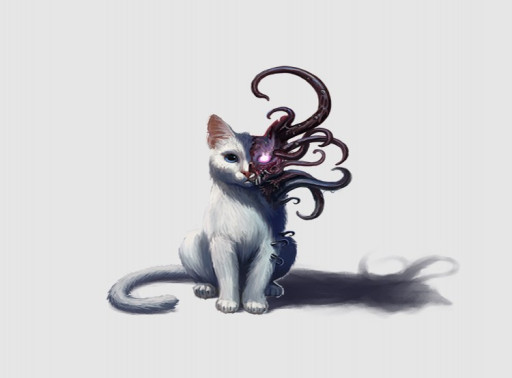
People like cats, Just look at the entirety of the Internet. Some aberrations take advantage of this.
The Angoyang is a cat-like aberration that uses its appearance to full effect. It creates an illusion to make itself look like a cat and hide its more aberrant features. Falling for the illusion makes the character fascinated.
Angoyangs can do damage with their tentacles and can also grab people. If a person is dependent on spells that require reflex saves, this may be a problem as Angoyangs have high reflex saves. Its silent yowl can do severe damage and cause fright.
Angoyang Stats
- Level 14
- Perception +25; dander scent (1 mile, imprecise), darkvision
- Languages Aklo
- Skills Acrobatics +27, Deception +27, Stealth +27, Survival +25
- Str +3, Dex +7, Con +4, Int +5, Wis +5, Cha +7
- I Am A Cat The angoyang has an automatic result of 47 to Deception checks and DCs to appear as a cat.
- Dander Scent The angoyang can imprecisely sense the location of any creature within 1 mile that has previously come in contact with the angoyang's fur.
- AC 35; Fort +24, Ref +29, Will +25
- HP 250
- Speed 35 feet
- Melee claw +27 [+23/+19] (agile, finesse), Damage 3d10+9 slashing
- Melee tentacles +27 [+22/+17] (finesse, reach 10 feet), Damage 3d12+9 piercing plus Grab
- Silent Yowl (auditory, fear, illusion, mental, occult) The angoyang opens its mouth and drops its innocent disguise, releasing its monstrous tentacles and letting out a blood-curdling scream directed at a single target that it can see to deal 8d10 mental damage. Only the target of this ability can hear this scream. The target must succeed at a DC 30 Will save as the sound tears through their mind.
- Critical Success The target takes no damage and is immune to Silent Yowl for 24 hours.
- Success The target takes half damage.
- Failure The target takes full damage and is frightened 1.
- Critical Failure The target takes double damage and is frightened 3.
- Slow Blink (enchantment, incapacitation, mental, occult, visual) The angoyang lets out a small meow and slowly blinks twice at a single creature. The target must attempt a DC 31 Will save. On a critical success, the target is unaffected and immune to Slow Blink for 24 hours. Otherwise, the creature is overcome with the urge to pet the angoyang's silken fur, becoming fascinated. If the angoyang attacks the creature, the creature can attempt a new save at the beginning of their next turn.
13. Hound of Tindalos
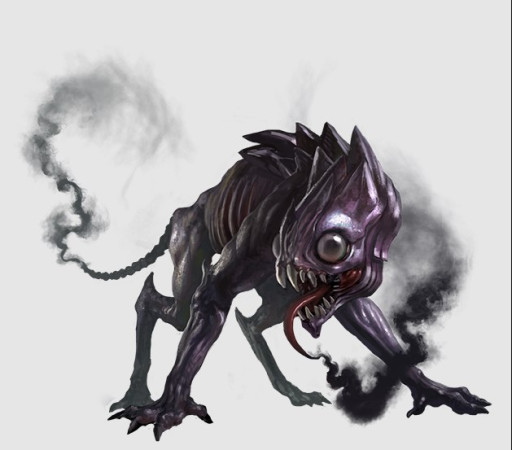
Sometimes, Pathfinders get caught up in time travel shenanigans. However, the various powers that be do not like people mucking about with the time stream. Anyone who crosses that line will be met by the Hounds of Tindalos.
These time-traveling dogs will chase time-travelers anywhere and anywhen they go. They attack in packs. If they gaze at a player, the player may take damage. They’re also tough physical attackers.
They have some interesting quirks. They lose some of their power in curved spaces (any space at a 90-degree angle or more). They also have buff spells like haste. The dogs aren’t subtle at all and prefer a direct confrontation. And the hounds will keep coming. How the players deal with the hounds long-term depends on the story. But most often, it means setting things right with the powers that be by undoing the effects of their time travel. This will often have tragic consequences.
Hound of Tindalos Stats
- Level 7
- Perception +17; greater darkvision
- Languages Aklo
- Skills Acrobatics +17, Athletics +15, Occultism +17, Stealth +17, Survival +13 (+17 to Track)
- Str +4, Dex +6, Con +2, Int +6, Wis +4, Cha +2
- AC 25; Fort +13, Ref +17, Will +15
- HP 90; Immunities controlled, emotion; Resistances mental 10, poison 10, physical 10
- Otherworldly Mind (mental) Whenever a creature targets the hound with a mental effect, that creature takes 4d6 mental damage (DC 25 basic Will save). On a critical failure, it also becomes confused for 1d4 rounds.
- Ripping Gaze (aura, evocation, occult, visual) 30 feet. The hound of Tindalos's eyes glow balefully, causing painful but bloodless wounds to rip open in the body of a creature that meets its awful gaze. When a creature ends its turn in the aura's emanation, it takes 4d6 slashing damage (DC 25 basic Fortitude save). A creature that critically succeeds at its save is temporarily immune for 24 hours.
- Vulnerable to Curved Space When a hound of Tindalos is not adjacent to a structural angle of 90º (or more acute), its resistance to physical damage is suppressed and it becomes sickened 1. It can't recover from this sickened condition, but the condition ends automatically once the hound is again adjacent to a suitable angle.
- Speed 30 feet, fly 30 feet
- Melee jaws +17 [+12/+7], Damage 2d10+7 piercing
- Melee claw +17 [+13/+9] (agile), Damage 2d8+7 slashing
- Occult Innate Spells DC 21; 8th discern location; 4th dimensional anchor; 3rd haste, slow; 2nd invisibility (self only)
- Angled Entry The hound of Tindalos casts a 4th-level dimension door spell, but it must transport itself into a space adjacent to an angle of 90º (or more acute) in the structure or environment around it. For example, it could teleport to a space adjacent to a wall (using the angle between the wall and floor) or a corner in a room, or adjacent to a sizable tree growing straight up out of the ground, but not to a flat plain or a room with only curved corners and edges.
- Once per day, the hound can use this ability to plane shift to or from the Dimension of Time, with the same restrictions on what angles it can appear next to.
12. Amalgamite
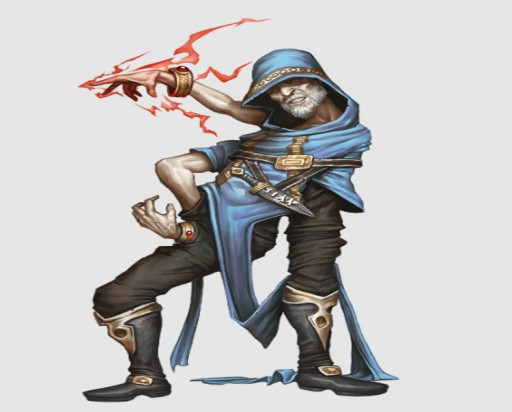
Teleportation is complicated. While spells like dimension door are common, they can and will go wrong if a caster is too arrogant or foolish to calculate properly. When that happens, you get an Amalgamite,
Amalgamites can make everyone around them feel displaced and sickened. Anyone who gets this affliction can spread it easily. They will sometimes destabilize their allied to spread the sickness.
The Amalgamites have another defensive ability. If attacked, they can trade places with a displaced creature. It is entirely possible that a party can hurt themselves this way. Watch out for the warp mind spell too. It can cause permanent confusion.
Amalgamate Stats
- Level 13
- Perception +23; low-light vision
- Languages Aklo, Common, Draconic
- Skills Arcana +27, Athletics +22, Lore +27 (any one subcategory), Occultism +27
- Str +5, Dex +6, Con +4, Int +8, Wis +6, Cha -1
- AC 33; Fort +22, Ref +22, Will +26
- HP 220, regeneration 10 (deactivated by piercing); Immunities controlled, mental; Resistances bludgeoning 10, slashing 10; Weaknesses piercing 10
- Destabilizing Field (aura, conjuration) 40 feet. A creature that begins its turn within the area feels its body begin to stretch and must succeed at a DC 33 Fortitude save or become destabilized. A destabilized creature emits a 10-foot destabilizing field aura and becomes sickened 1. The destabilization ends when the creature is no longer sickened. A creature that succeeds at its saving throw against the aura is temporarily immune to all destabilizing fields for 1 minute.
- Displace Trigger The amalgamite is hit by a Strike; Effect The amalgamite Repositions itself or Transposes itself with another creature. If the amalgamite successfully changes its location, it and any Transposed creature take half damage from the triggering Strike.
- Speed 25 feet
- Melee limb +24 [+19/+14], Damage 3d10+11 bludgeoning
- Ranged warping ray +27 [+22/+17] (deadly 2d8, magical, range 100 feet), Damage 3d8+8 force
- Occult Innate Spells DC 33; 7th ethereal jaunt, warp mind; 4th blink (×2)
- Reposition (concentrate, conjuration, occult, teleportation) The amalgamite teleports into an unoccupied space it can see within 50 feet.
- Transpose (conjuration, occult, teleportation) The amalgamite chooses up to two destabilized creatures they can see within 50 feet and swaps their positions, or moves a single such creature to an unoccupied space they can see within range. If the amalgamite chooses two creatures, they can choose their self as one of these creatures, but both targets must be the same size. An unwilling creature can attempt a DC 33 Will save. If either target succeeds at this saving throw, both are unaffected.
11. Brain Collector
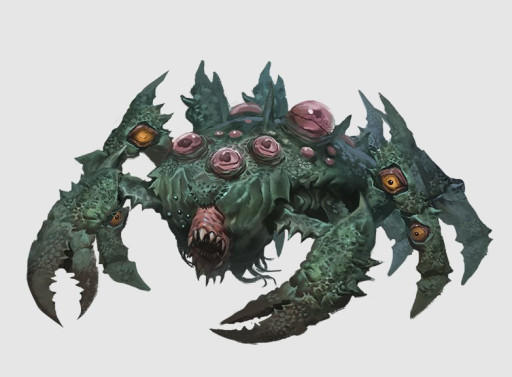
This scorpion-like entity hails from deep space. It’s part of a group of invaders called the Dominion of the Black. The brain collector has one goal: Collect brains.
To do this, they kill people and store their brains in little pods on their bodies. Their methods of killing vary. They can attack with melee and inject poison that can inflict stupefy. They can also use magic.
This magic can include phantasmal killer While this spell is not strong as it was in 1st edition, it can still be pootentially deadly. If you attack a brain collector and do 30 mental damage or do 25 damage on a critical attack, you can destroy one of the brain pods.
Brain Collector Stats
- Level 8
- Perception +18; darkvision
- Languages Abyssal, Aklo, Common, Draconic, Protean, Undercommon; telepathy 100 feet
- Skills Acrobatics +17, Arcana +18, Athletics +16, Lore +18 (all subcategories), Occultism +21, Stealth +17
- Str +6, Dex +3, Con +5, Int +4, Wis +4, Cha +3
- AC 26; Fort +15, Ref +13, Will +18; +1 status to all saves vs. magic
- HP 140; Immunities confused ; Weaknesses brain loss
- Brain Blisters A brain collector has seven brain blisters on its back that it uses to house stolen brains. A brain collector without all seven blisters full is stupefied with a value equal to the number of empty blisters.
- Brain Loss If a brain collector takes 30 damage from a critical hit or takes 25 mental damage, it must succeed at a DC 26 save (Fortitude for critical damage or Will for mental damage) or one of its brain blisters is destroyed.
- Speed 25 feet, fly 30 feet
- Melee jaws +20 [+15/+10], Damage 2d12+6 piercing plus brain collector venom
- Melee claw +20 [+16/+12] (agile), Damage 2d8+6 slashing
- Occult Spontaneous Spells DC 26, attack +18; 4th confusion, phantasmal killer (2 slots); 3rd dispel magic, haste, paralyze (3 slots); 2nd humanoid form, invisibility, mirror image, paranoia (4 slots); 1st mindlink, ray of enfeeblement, true strike, unseen servant (4 slots); Cantrips (4th) dancing lights, detect magic, mage hand, prestidigitation
- Brain Collector Venom (poison) Saving Throw DC 26 Fortitude; Maximum Duration 6 rounds; Stage 1 1d6 poison damage and enfeebled 1 (1 round); Stage 2 1d6 poison damage, enfeebled 1, and slowed 1 (1 round); Stage 3 2d6 poison damage, enfeebled 2, and slowed 1 (1 round)
- Collect Brain (manipulate) The brain collector collects a brain of a creature that has been dead for no more than 1 minute. It can then use an Interact action to secure the brain in one of its empty brain blisters
10. Children of Mhar
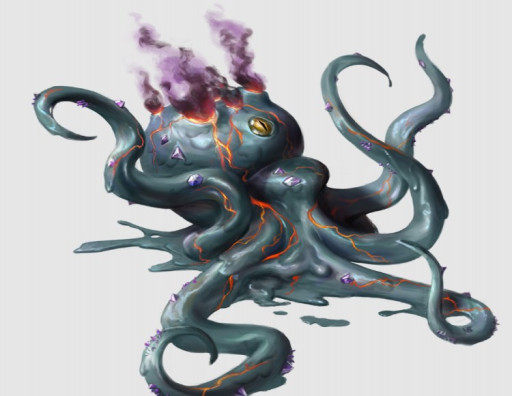
Aberrations sometimes come to Golarian from deep in the cosmos. Children of Mhar are the children of the aforementioned Great Old One. Though they are children, they can give Pathfinders a run for their money.
These multi-tentacled creatures are powerful fighters whatever strategy they’re using. They can grab Pathfinders and take a bite out of them. They can also use a multi-attack to strike three opponents. They also have strong defenses. They can resist physical damage and can deflect enchantment spells.
On the ranged end, it can shoot balls of lava. It can also create earthquakes that do severe damage and render terrain difficult. Flying won’t help because the creature can use earthbind and make it so creatures can’t fly. They can also spew toxic smog that renders players vulnerable to hallucination spells.
Children of Mhar Stats
- Level 18
- Perception +30; greater darkvision, smoke vision
- Languages Aklo; telepathy 100 feet
- Skills Athletics +37
- Str +9, Dex +6, Con +8, Int -1, Wis +0, Cha +4
- Smoke Vision The deghuun ignores the concealed condition from smoke or smog, including from Sulfurous Plume.
- AC 42; Fort +34, Ref +30, Will +26
- HP 420; Immunities fire, poison; Resistances physical 10 (except adamantine); Weaknesses cold 10, good 10
- Unfathomable Aspect Anytime a deghuun attempts a Will save against an enchantment spell, the spell's caster must attempt a DC 38 Will save or become confused for up to the spell's duration
- Speed 40 feet, climb 40 feet
- Melee tentacle +35 [+31/+27] (agile, reach 20 feet), Damage 3d10+17 bludgeoning plus Grab
- Ranged lava ball +34 [+29/+24] (brutal, range increment 60 feet), Damage 4d6+17 bludgeoning plus 3d6 fire
- Divine Innate Spells DC 38; 8th earthquake; 6th earthbind (×3), hallucination
- Beak Crunch Requirements The deghuun has a creature grabbed with its tentacles; Effect The creature takes 4d8+17 piercing damage.
- Sulfurous Plume (fire, poison) The deghuun vents caustic smog for 1d4 rounds. Any creature that ends its turn within 30 feet of the deghuun during this time takes 6d6 fire damage and is sickened 1 (DC 38 Fortitude save; the creature avoids the sickened condition on a critical success, or is sickened 2 on a critical failure). While sickened in this way, a creature takes a –2 status penalty to its saving throw against the deghuun's hallucination. Any creature that's in the smog is concealed and treats other creatures as concealed. Strong winds dissipate the smog.
- Tentacle Assault The deghuun makes three tentacle Strikes, each against a different creature within reach. These attacks count toward its multiple attack penalty as normal.
9. Choker

If you’re doing an aberration-based campaign, a Choker is a good low-level monster to start with. These small creatures from parts unknown, are curious about our society. Unfortunately, it chooses to explore this curiosity by strangling people and stealing their stuff.
Chokers are low-level monsters but they can still be a threat. Getting hit by them allows them to instantly start strangling players. They can also reposition the players they are strangling if they are attacked.
Chokers can use hidden movement to attack any creature that doesn’t detect it. If Chokers feel outnumbered, it will run away, using its ability to squeeze into tight spaces to its advantage. If the party is seeking an object a Choker has stolen, this can be a good chase sequence.
Choker Stats:
- Level 2
- Perception +7; darkvision
- Languages Aklo, Undercommon
- Skills Athletics +9 (+11 to Grapple), Stealth +9
- Str +3, Dex +3, Con +1, Int -3, Wis +1, Cha -2
- AC 18; Fort +7, Ref +10, Will +7
- HP 28
- Yank (manipulate) Trigger An enemy targets the choker with an attack; Effect The choker tries to pull a creature it has grabbed or restrained into the path of the attack. The choker attempts an Athletics check, including its bonus to Grapple. If it succeeds against the grabbed or restrained creature's Fortitude DC, the choker redirects the attack to that creature, and the attacker compares its attack roll result against the new target's AC.
- The choker must move the creature into a space adjacent to itself. The creature must also be moved within the attacker's reach against a melee attack or into a space between itself and the attacker against a ranged attack. The choker can't use this ability to make the attacker target itself, even if it's grabbing or restraining the attacker.
- Speed 20 feet, climb 15 feet
- Melee arm +11 [+6/+1] (reach 10 feet), Damage 1d6+3 bludgeoning plus strangling fingers
- Constrict 1d6+3 bludgeoning, DC 19
- Hidden Movement If the choker starts its turn hidden from or undetected by a creature, that creature is flat-footed against the choker's attacks until the end of the turn.
- Strangling Fingers Any creature hit by a choker's arm Strike is automatically grabbed, and the choker begins to strangle the target. The creature is suffocating and can't speak as long as it's strangled. This prevents it from casting spells with a verbal component or activating items with a command component.
8. Dark Naga
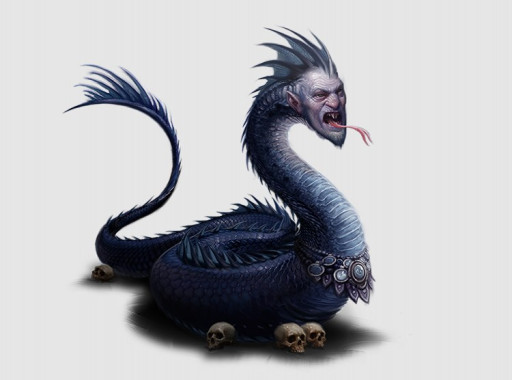
Nagas like money and treasure. They’re willing to kill to get it. Even the basic Dark Naga has enough power to do a lot of damage,
The Dark Naga has powerful fangs that do significant damage. The fangs inject strong venom that can render a player unconscious for multiple minutes, taking them out of the fight. A particularly brutal GM can have the nagas attack the unconscious player.
What can make the Dark Naga brutal is its magic. It can cast wall of fire and lightning brutal. Invisibility gives them the chance to sneak up on the party and inject its venom into a character with low fortitude.
Dark Naga Stats
- Level 7
- Perception +15; mind reading 30 feet, darkvision
- Languages Aklo, Common
- Skills Acrobatics +17, Arcana +16, Athletics +13, Deception +16, Intimidation +16, Stealth +19
- Str +2, Dex +6, Con +4, Int +3, Wis +2, Cha +3
- AC 27; Fort +15, Ref +17, Will +15; guarded thoughts
- HP 115
- Guarded Thoughts (abjuration, occult) Dark nagas are immune to any form of mind reading.
- Speed 30 feet
- Melee fangs +19 [+15/+11] (agile, finesse), Damage 2d8+5 piercing plus dark naga venom
- Arcane Spontaneous Spells DC 26, attack +18; 4th blink, wall of fire (3 slots); 3rd dispel magic, haste, lightning bolt (4 slots); 2nd illusory creature, invisibility, magic missile (4 slots); 1st feather fall, illusory object, longstrider (4 slots); Cantrips (4th) daze, detect magic, mage hand, read aura, shield
- Occult Innate Spells DC 25; Constant (3rd) mind reading
- Dark Naga Venom (incapacitation, poison) Saving Throw DC 25 Fortitude; Maximum Duration 5 minutes; Stage 1 slowed 1 (1 round); Stage 2 slowed 2 (1 round); Stage 3 unconscious with no Perception check to wake up (1d4+1 minutes)
7. Dread Wisp
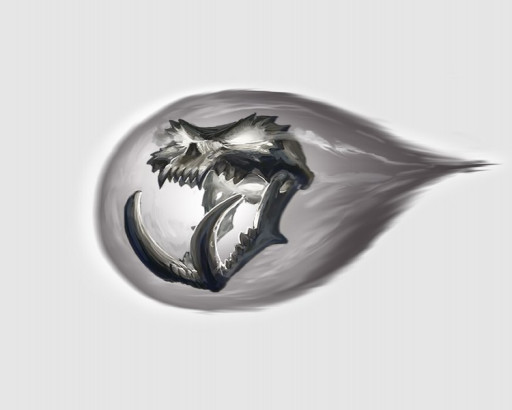
An angry spirit related to the Will-o’-Wisp. They cause and feed on fear. And more importantly, they’re hard to hit.
They can go invisible at will without limit. They’ll reappear to attack and then disappear again. If dealing with multiple, wisps, this can become a battle of attrition.
Unfortunately for players, using area-of-effect magic to bypass invisibility will not work. So they’ll have to find a way to bypass the invisibility using glitterdust.or some other method. They will need to figure out a way to see too. The dread wisps can switch locations with Shadow Flitter.
Dread Wisp Stats:
- Level 8
- Perception +20; darkvision
- Languages Aklo, Common
- Skills Acrobatics +23, Deception +16, Intimidation +16, Stealth +23
- Str -5, Dex +6, Con +0, Int +2, Wis +4, Cha +2
- AC 31; Fort +14, Ref +21, Will +18
- HP 90 (negative healing); Immunities magic; Weaknesses positive 10
- Dread Flickering (aura, light) 20 feet. A dread wisp, though naturally invisible, glows with a grayish illumination, casting dim light in the aura and making them visible. Living creatures that end their turn in the aura must succeed at a DC 25 Will saving throw or become frightened 1 (or frightened 2 on a critical failure). Those that critically succeed are temporarily immune for 10 minutes.
- Magic Immunity A dread wisp is immune to all spells except faerie fire, magic missile, maze, searing light, and spells with the positive trait.
- Speed fly 50 feet
- Melee draining touch +17 [+12/+7] (magical, negative), Damage 3d8+8 negative plus wearying touch
- Feed on Despair (concentrate, necromancy, negative, occult) Frequency once per round; Requirement An enemy within 15 feet of the dread wisp is under a fear effect, drained, or dying; Effect The dread wisp feeds on the creature's despair. The dread wisp regains 2d8 Hit Points and deals 3d8 negative damage to the creature (DC 25 basic Fortitude save), and if the dread wisp has Gone Dark, their Dread Flickering reignites.
- Go Dark (concentrate) The dread wisp extinguishes their Dread Flickering, becoming invisible. They can end this effect with another use of this action. If the dread wisp uses their draining touch Strike while invisible, the arc of pale energy lets any observer determine their location, making them hidden to all observers only until the dread wisp moves.
- Shadow Flitter (conjuration, occult, teleportation) The dread wisp teleports to a square they can see within 30 feet that isn't in an area of bright light. The dread wisp can't use Shadow Flitter again for 1d4 rounds.
- Wearying Touch If the dread wisp critically hits with their draining touch Strike, the target is drained 1.
6. Drider
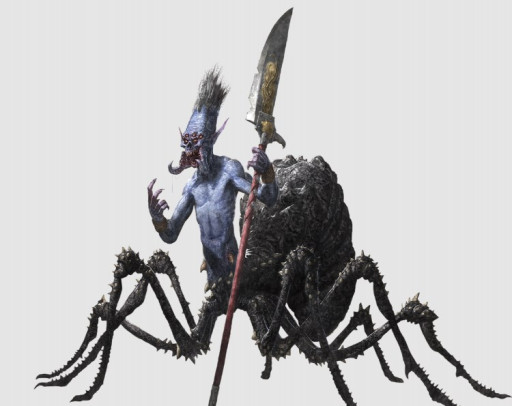
The drow are infamous for using their dark magic to create aberrations. One of these is the Drider. Drow slaves volunteer to be fleshwarped and turned into spider-like monstrosities to serve as guardians for a period of time in exchange for their freedom. However, they usually don’t live long enough to complete that contract,
Like most drow, the Drider are good with a multitude of weapons. It poses a threat in close and long-range combat. The fleshwarpping process gives them access to powerful venom that can enfeeble party members.
The Drider can also shoot webs to slow down or trap party members. The webs can immobilize opponents. This makes a Drider a threat if encountered in groups. A Drider can also use powerful magic including suggestion and fireball.
Drider Stats
- Level 6
- Perception +13; darkvision
- Languages Elven, Undercommon
- Skills Arcana +14, Athletics +12, Intimidation +14, Religion +13, Stealth +15
- Str +4, Dex +3, Con +3, Int +2, Wis +3, Cha +4
- Items +1 composite longbow (20 arrows), glaive
- AC 24; Fort +13, Ref +13, Will +15; +1 status to all saves vs. magic
- HP 95; Immunities sleep
- Speed 30 feet, climb 20 feet
- Melee glaive +16 [+11/+6] (deadly 1d8, forceful, reach 10 feet), Damage 1d8+10 slashing
- Melee fangs +16 [+11/+6], Damage 1d6+10 piercing plus drider venom
- Ranged composite longbow +16 [+11/+6] (deadly d10, magical, propulsive, range increment 100 feet, reload 0, volley 50 feet), Damage 1d8+8 piercing
- Ranged web +15 [+10/+5] (range increment 30 feet), Effect web trap
- Arcane Innate Spells DC 20; 4th clairvoyance, suggestion; 3rd clairaudience, dispel magic, levitate; 2nd darkness (at will), faerie fire (at will); Cantrips (3rd) dancing lights, detect magic
- Arcane Prepared Spells DC 24, attack +17; 3rd fireball; 2nd acid arrow, invisibility; 1st magic missile (x2), ray of enfeeblement; Cantrips (3rd) ghost sound, mage hand, ray of frost
- Drider Venom (poison) Saving Throw DC 23 Fortitude; Maximum Duration 6 rounds; Stage 1 1d8 poison damage and enfeebled 1 (1 round)
- Web Trap A creature hit by a drider’s web attack is immobilized and stuck to the nearest surface (Escape DC 21).
5. Ghonhatine
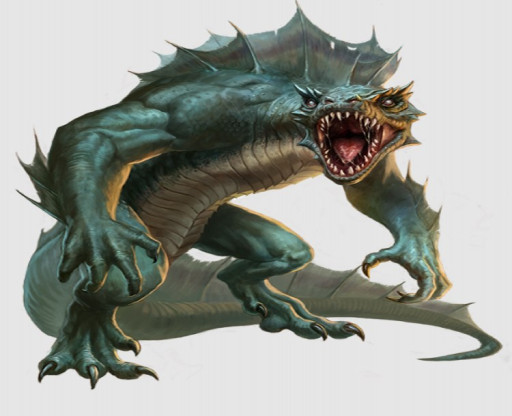
When it comes to creating abominations, the drow can be equally innovative and horrifying. In an attempt to recreate an extinct monster, the drow created the Ghonhatine. Whether the creation is faithful to the original is irrelevant. It’s still horrifying.
The Ghonhatine is a physical powerhouse. They can be a problem when paired or when accompanied by other enemies. Their jaws can do additional acid damage.
Their vomit can be used as a ranged attack. They can inflict a disease that can kill a character. However, the big problem is that if a character dies during an encounter with a Ghonhatine, the Ghonhatine will try to eat the dead body, making the character that much harder to resurrect.
Ghonhatine Stats
- Level 10
- Perception +19; darkvision, scent (imprecise) 30 feet
- Languages Undercommon
- Skills Athletics +21, Intimidation +19, Stealth +19
- Str +7, Dex +3, Con +6, Int -2, Wis +5, Cha +3
- AC 30; Fort +22, Ref +17, Will +19
- HP 175; Immunities disease; Resistances acid 10
- Stench (aura, olfactory) 30 feet. A creature entering the aura or starting its turn in the aura must succeed at a DC 26 Fortitude save or become sickened 1 (plus slowed 1 for as long as it's sickened on a critical failure). While within the aura, affected creatures take a –2 circumstance penalty to saves against disease and to recover from the sickened condition. A creature that succeeds at its save is temporarily immune for 1 minute.
- Speed 35 feet
- Melee jaws +23 [+18/+13] (reach 10 feet), Damage 2d12+10 piercing plus 1d6 persistent acid
- Melee claw +23 [+19/+15] (agile, reach 10 feet), Damage 2d10+10 slashing
- Ranged vomit +19 [+14/+9] (acid, range increment 20 feet), Damage 5d6 acid plus fleshgout
- Feed (manipulate) Requirement The ghonhatine is adjacent to the corpse of a creature that died within the last hour; Effect The ghonhatine devours a chunk of the corpse. For 1 minute, the ghonhatine gains fast healing 5 and a +2 status bonus to damage rolls. It can gain these benefits from any given corpse only once.
- Fleshgout (disease) A ghonhatine's vomit carries an awful disease that, over time, can cause a suffering creature's flesh to develop painful boils that eventually slough away, leaving gaping wounds; Saving Throw DC 28 Fortitude; Stage 1 carrier with no ill effect (1d4 hours); Stage 2 enfeebled 1 and drained 1 (1 day); Stage 3 enfeebled 2 and drained 2 (1 day); Stage 4 enfeebled 2 and drained 3 (1 day); Stage 5 drained 4, enfeebled 2, and unconscious (1 day); Stage 6 dead
4. Intellect Devourer
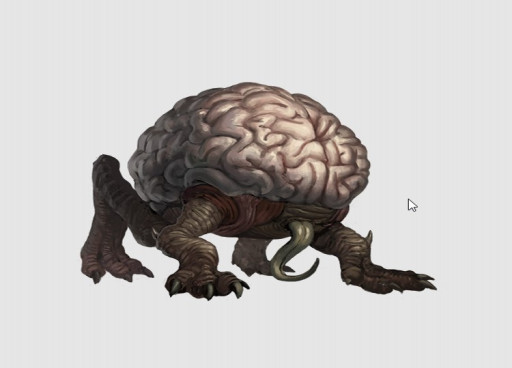
The Dominion of the Black is always trying to infiltrate societies. Their advance scouts are Intellect Devourers. While some might think that advance scouts are less of a threat, this is a mistake.
Intellect Devourers can steal bodies and possess people. Usually taking their physical abilities and general knowledge in the process. If the creature takes a fighter for example, they will have the abilities of the fighter. Once the body is destroyed, this walking brain will try to possess another body.
The big challenge with this fight is not just dealing with the possessed body, but killing the creature quickly. It will hop from body to body. Each time it does this, it heals completely. And it may keep some underlings in the encounter for spare parts.
Intellect Devourer Stats
- Level 8
- Perception +16; darkvision, lifesense 60 feet
- Languages Aklo, Common, Undercommon; can't speak any languages; telepathy 100 feet
- Skills Athletics +14, Deception +20, Diplomacy +16, Occultism +17, Society +17, Stealth +18
- Str +2, Dex +4, Con +4, Int +5, Wis +4, Cha +6
- AC 26; Fort +14, Ref +16, Will +18
- HP 130; Immunities blinded, controlled, emotion, possession
- Speed 35 feet
- Melee talon +18 [+14/+10] (agile, finesse), Damage 2d10+5 slashing
- Occult Innate Spells DC 27; 4th confusion, globe of invulnerability; 3rd soothe (×3); 2nd gentle repose, invisibility (at will; self only), paranoia (at will); Cantrips (4th) daze, detect magic, read aura
- Body Thief (manipulate, necromancy, occult, possession) The intellect devourer reduces in size and burrows into the brain of a creature dead for no longer than 1 day. At the start of the intellect devourer's next turn, the body revives at its maximum Hit Points, controlled by the devourer. The intellect devourer is conscious and can sense everything the possessed body could. Any effect that ends the possession kills the host body with the same effects as Exit Body. The intellect devourer can't use any of the host creature's spells with Body Thief but can use its own spells. The host body slowly decays while inhabited by the intellect devourer, becoming uninhabitable after 7 days unless preserved with gentle repose or a similar effect.
- Exit Body (move) Requirements The intellect devourer is controlling a body with Body Thief; Effect The intellect devourer leaves its host body, which dies instantly and is no longer a suitable host for any Body Thief ability. The intellect devourer appears at full size in an adjacent space.
- Ravage The intellect devourer makes two talon Strikes against a paralyzed, restrained, or unconscious creature, using the same attack modifier as its highest attack modifier. These Strikes gain the death trait. If Ravage kills the target, the intellect devourer may use Body Thief against it as a free action.
- Stolen Identity While an intellect devourer uses Body Thief, it gains the ability to understand and speak all languages known by the host, as well as knowledge of the host body's abilities, identity, role in society, and personality. However, it does not gain the specific memories or knowledge of the host body.
3. Shanrigol Behemoth
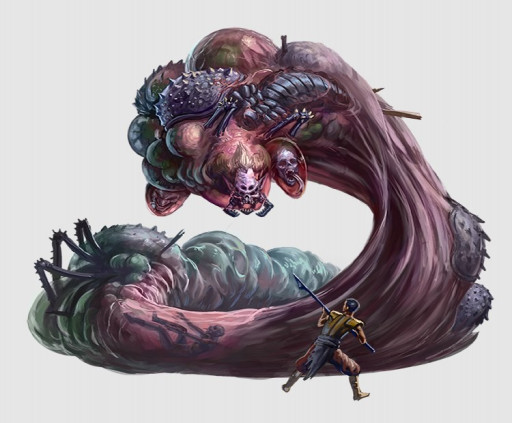
A Shanrigol Behemoth is created from a Shanrigol Heap that has grown large enough to become a real threat. While not evil, it seeks to consume anything it sees, And Pathfinders count as anything.
This gargantuan monstrosity has strong defenses. They resist bludgeoning and piercing damage. They fight by grabbing opponents, shredding their flesh, and squeezing the life out of them. Each time the behemoth does this, it regains hit points. The ability to shoot web and immobilize party members is a major threat.
This creature can cause persistent bleed damage. As long as the character is bleeding, they are enfeebled. This fight is a slugfest but players will want to get clear. When destroyed, it’ll explode in a pile of stench.
Shanrigol Behemoth Stats
- Level 9
- Perception +18; darkvision, tremorsense (imprecise) 30 feet
- Skills Athletics +20, Stealth +16
- Str +7, Dex +4, Con +3, Int -4, Wis +3, Cha -5
- AC 27 all-around vision; Fort +21, Ref +18, Will +16
- HP 140 (negative healing); Immunities death effects, disease, paralyzed, poison, unconscious; Resistances slashing 10, piercing 10; Weaknesses positive 10
- Necrotic Decay (divine, necromancy, negative) When the shanrigol behemoth dies, its flesh rots away and sublimates into a foul-smelling gas that fills a 5-foot emanation around the body. This gas deals 9d6 negative damage to creatures in this area as their flesh curdles and rots as well (DC 27 basic Fortitude save).
- Speed 30 feet, climb 20 feet, swim 20 feet
- Melee fleshy slap +21 [+16/+11] (forceful, reach 15 feet), Damage 2d10+11 bludgeoning plus Grab
- Ranged bone shard +18 [+14/+10] (agile, range increment 30 feet, versatile P), Damage 1d12+11 bludgeoning
- Ranged web +18 [+13/+8] (range increment 30 feet), Effect web trap
- Sapping Squeeze Requirements The shanrigol has a creature grabbed; Effect The shanrigol squeezes the life essence from its target, dealing 1d10+11 bludgeoning and 1d6 persistent bleed damage (DC 25 basic Fortitude save). The shanrigol regains temporary Hit Points equal to half the amount of bludgeoning damage a single target takes; these temporary Hit Points last for 1 minute.
- Shred Flesh A shanrigol behemoth's attacks brutally rend its foes. Creatures critically hit by the shanrigol's fleshy slap Strike take an additional 2d6 persistent bleed damage and are enfeebled 1 for as long as they are bleeding.
- Undulating Step The shanrigol separates its flesh from its bones to fit through small spaces. It Strides, ignoring difficult terrain and fitting through tight spaces as though it were a Tiny creature. It can't use any actions other than Undulating Step until it occupies an area large enough for its normal form.
- Web Trap A creature hit by the shanrigol behemoth's web attack is immobilized and stuck to the nearest surface until it can Escape
2. Veiled Masters

The Veiled Masters covertly controlled the world for eons. Once humans in Azlant started getting wise to the scheme, the Veiled Masters decided to drop a meteor on the situation. Unfortunately for the Veiled Masters, they also got up in the blast. However, they survived and are always plotting ways to reassert control.
The Veiled Masters’ main tactic is to control things from afar, rarely getting their own fins dirty. When they’re forced into direct combat, they’re still powerful. Their physical are brutal. Their slime can inflict the drained status which lowers max HP. Their tentacles can also do electricity damage.
The real threat is the spells. Veiled Masters are masters of illusion and enchantment. They can cast things like dominate and suggestion. They can turn the party against each other quickly.
Veiled Masters Stats
- Level 14
- Perception +25; darkvision
- Languages Aklo, Alghollthu, Aquan, Common, Undercommon; tongues
- Skills Arcana +27, Athletics +24, Deception +28, Intimidation +26, Lore +29 (any one subcategory), Occultism +29, Society +27, Stealth +24
- Str +6, Dex +6, Con +8, Int +7, Wis +5, Cha +6
- Mucus Cloud (aura, disease) 30 feet. While underwater, a veiled master exudes a cloud of transparent slime. An air-breathing creature within 30 feet of a veiled master must succeed at a DC 36 Fortitude save each round or lose the ability to breathe air but gain the ability to breathe water for 24 hours.
- AC 34; Fort +26, Ref +22, Will +24; +2 status to all saves vs. magic
- HP 270; Immunities controlled, electricity, mental ; Resistances cold 20
- Speed 10 feet, swim 80 feet
- Melee claw +30 [+26/+22] (agile, magical, reach 20 feet), Damage 3d10+12 slashing plus slime
- Melee fangs +28 [+24/+20] (agile, magical, reach 10 feet, versatile S), Damage 3d8+12 piercing plus slime and consume memories
- Melee tentacle +28 [+24/+20] (agile, electricity, magical, reach 20 feet), Damage 7d6 electricity plus thoughtlance
- Occult Innate Spells DC 37; 9th project image (at will); 8th illusory scene (at will), suggestion (x3); 7th veil (at will); 6th dominate (x3); 5th dimension door (x3), hallucinatory terrain (at will), illusory object (at will); 3rd hypnotic pattern (at will), levitate (at will), mind reading (at will), secret page (at will); Constant (5th) tongues
- Occult Rituals DC 37; 5th geas
- Change Shape (concentrate, occult, polymorph, transmutation) Once per round, a veiled master can take on the appearance of a humanoid of Large, Medium, or Small size or resume its true form. While in humanoid form, the veiled master’s Speed is 30 feet, and it loses its mucus cloud aura and swim Speed. If the humanoid form assumed lacks the aquatic trait, the veiled master loses its own aquatic trait as well. In humanoid form, the veiled master can use weapons, or it can make Strikes that work like its tentacle attack but use the reach of its current form. If the assumed form has fangs or claws, the veiled master can also make such Strikes, but these attacks lack the veiled master’s slime.
- Consume Memories (mental, occult) When a veiled master makes a fangs Strike against a creature, it can consume some of that creature’s memories. The target must succeed at a DC 37 Fortitude saving throw or become stupefied 1. A veiled master regains 5 Hit Points each time it successfully consumes memories. When a veiled master consumes memories, it learns some of the creature’s memories (subject to the GM’s discretion).
- Delayed Suggestion (enchantment, occult) When a veiled master successfully casts dominate on a creature, a suggestion spell triggers when the dominate spell ends. This suggestion usually causes the target to return to the veiled master, so the creature can cast dominate again, but a veiled master can set the suggestion to different orders if it wishes.
- Slime (curse, occult, virulent) Saving Throw Fortitude DC 36; Stage 1 no ill effect (1 round); Stage 2 the victim’s skin softens, inflicting drained 1 (1 round); Stage 3 the victim’s skin transforms into a clear, slimy membrane, inflicting drained 2 until the curse ends; every hour this membrane remains dry, the creature’s drained condition increases by 1 (permanent). A remove disease spell can counteract this curse, but immunity to disease offers no protection against it.
- Tentacle Flurry The veiled master thrashes about with its tentacles. Make a tentacle Strike against each creature within its reach. Roll only one attack roll, and roll the damage only once for all targets.
- Thoughtlance (curse, enchantment, occult) A creature touched by the veiled master’s tentacles, whether those tentacles deal damage or not, must attempt a DC 34 Will save, becoming slowed 1 on a failure or slowed 2 on a critical failure. Each time the affected creature ends its turn, its slowed value decreases by 1.
1. Worm that Walks

Some wizards don’t care for the whole death concept. If they don’t come to terms with it, they’ll delve into dark magic. Some will become liches. But more creative wizards will take the worms that will consume their corpse and make a body out of them. It’s as horrific as it sounds.
Since they’re powerful wizards, they have powerful spells. Spells like phantasmal killer and warp mind can kill or permanently incapacitate a character. Other spells like dominate create more problems for the party.
For all the trouble these wizards go through to stay alive, they have many defenses to prevent players from putting them in the ground. If a party brings this wizard’s HP to 0, it will discorporate into a swarm and scatter. If one worm survives, it will reform.
Worm that Walks Stats
- Level 14
- Perception +25; darkvision, tremorsense (imprecise) 30 feet
- Languages Aklo, Common
- Skills Acrobatics +24, Deception +28, Intimidation +26, Occultism +27, Society +23, Stealth +28
- Str +5, Dex +8, Con +5, Int +5, Wis +4, Cha +8
- AC 36 all-around vision; Fort +23, Ref +28, Will +26
- HP 200 (fast healing 10); Immunities disease, paralyzed, poison, precision, swarm mind, unconscious; Resistances physical 10; Weaknesses area damage 10, splash damage 10
- Discorporate When the worm that walks is reduced to 0 HP, it discorporates and the component worms that make up its body disperse in every direction. If even a single worm escapes, the worm that walks will eventually re-form using a process that typically takes 1d10 days.
- While the exact circumstances and surroundings determine how long the worm that walks's foes have to dispatch the fleeing worms before they escape, usually its foes have only a single round. Typically, this requires the application of an area effect or splash weapon within 1 round to the space where the worm that walks collapsed. After any amount of area or splash damage is dealt to that space, the character dealing the damage must attempt a DC 15 flat check. Each subsequent area or splash damage effect performed on the area reduces the DC of this flat check by 2, to a minimum of DC 5. If any of these flat checks succeed, none of the worms escape, and the worm that walks is destroyed permanently. At the GM's discretion, clever means of trapping or otherwise detaining the vermin may extend the time allowed to finish off the worm that walks.
- Speed 30 feet
- Melee tendril +29 [+24/+19] (reach 10 feet), Damage 4d8+14 persistent piercing damage
- Occult Spontaneous Spells DC 34, attack +26; 7th phantasmal killer, visions of danger, warp mind (3 slots); 6th dispel magic, dominate, paranoia, summon entity (4 slots); 5th black tentacles, mind probe, phantom pain, subconscious suggestion (4 slots); 4th dimension door, modify memory, suggestion, veil (4 slots); 3rd dream message, haste, hypercognition, slow (4 slots); 2nd comprehend language, illusory creature, mirror image, undetectable alignment (4 slots); 1st charm, illusory disguise, mindlink, ray of enfeeblement (4 slots); Cantrips (7th) daze, detect magic, light, mage hand, shield
- Squirming Embrace The worm that walks Strides, ending its movement sharing a space with a creature, and deals 5d8 piercing damage to the creature. The creature can attempt a DC 32 basic Reflex save.
- Swarm Shape (concentrate) The worm that walks collapses into a shapeless swarm of worms. It drops all held, worn, and carried items. While discorporated, the worm that walks can't use attack actions and can't cast spells, but it can move through areas small enough for its individual worms to fit without having to Squeeze. It can use the same action to coalesce back into its normal form.
